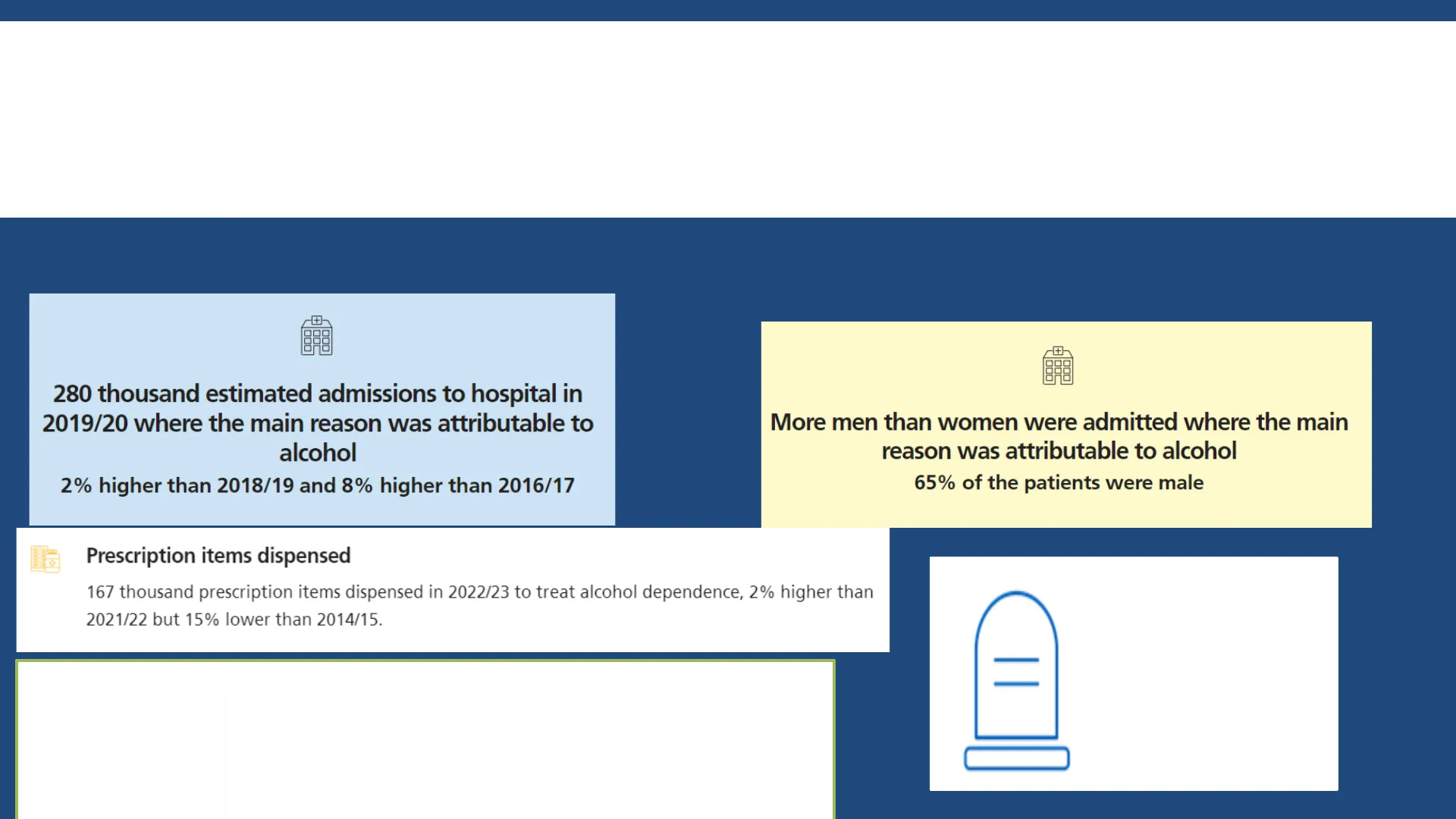Alcohol Misuse: Implications, Treatment, and GABA Receptors
Slides from World Health Organization about Alcohol Misuse. The Pdf, a presentation for University Biology students, covers alcohol misuse, its short and long-term implications, and treatments for dependence and withdrawal, including GABA receptor pathophysiology.
See more25 Pages


Unlock the full PDF for free
Sign up to get full access to the document and start transforming it with AI.
Preview
ALCOHOL MISUSE
After this lecture, you should be able to:
- Understand alcohol intake and NHS recommendations
- Understand the short and long term implications of alcohol misuse
- Understand treatment of alcohol withdrawal and dependency
- Understand the role of community pharmacists
What is alcohol?
"Alcohol is a psychoactive substance with dependence-producing properties" World Health Organization
280 thousand estimated admissions to hospital in 2019/20 where the main reason was attributable to alcohol
2% higher than 2018/19 and 8% higher than 2016/17 More men than women were admitted where the main reason was attributable to alcohol 65% of the patients were male
Prescription items dispensed
167 thousand prescription items dispensed in 2022/23 to treat alcohol dependence, 2% higher than 2021/22 but 15% lower than 2014/15.
Highest risk drinking behaviour/risk of dependence amongst 16-24 year olds NHS digital
65% of hospital admissions were men (up from 62%) Deaths have increased by 11% since 2006 - 67% men 3 million deaths worldwide
10,048 alcohol-specific deaths in 2022 - the highest on record
What are alcohol units?
- Alcohol units were first introduced in the UK in 1987 to help people keep track of their drinking
- Units are a way of expressing the quantity of pure alcohol in a drink
- One unit = 10ml or 8g of pure alcohol
- " One unit = the amount of alcohol the average adult can process in an hour
- The number of units in a drink is based on the size of the drink and its alcohol strength
Alcohol Units by Type of Drink
| Type of drink | Number of alcohol units |
| Single small shot of spirits* (25ml, ABV 40%) | 1 unit |
| Alcopop (275ml, ABV 5.5%) | 1.5 units |
| Small glass of red/white/rosé wine (125ml, ABV 12%) | 1.5 units |
| Bottle of lager/beer/cider (330ml, ABV 5%) | 1.7 units |
| Can of lager/beer/cider (440ml, ABV 5.5%) | 2.4 units |
| Pint of lower-strength lager/beer/cider (ABV 3.6%) | 2 units |
| Standard glass of red/white/rosé wine (175ml, ABV 12%) | 2.1 units |
| Pint of higher-strength lager/beer/cider (ABV 5.2%) | 3 units |
| Large glass of red/white/rosé wine (250ml, ABV 12%) | 3 units |
How do you calculate a unit?
- Alcohol By Volume (ABV) is a measure of the amount of pure alcohol as a percentage of the total volume of liquid in a drink.
- For example, wine that says "14% ABV" or "alcohol volume 14%" means that 14% of the volume of that drink is pure alcohol.
Units = ABV (%) x Volume (ml) 1,000
Measures
- Pint = 568ml
- Single measure of spirits = 25ml
- Double measure of spirits = 50ml
- A shot = 25ml
Worked Example
- A pint of cider is 4% ABV. How many units are present in one pint?
- 1 pint = 568ml
Units = ABV (%) x Volume (ml) 1,000
Units = 4 (%) x 568 (ml) = 2.3 U its 1,000
NHS recommendations on units
- No more than 14 units a week for both men and women
- Do not 'save up' the 14 units for 1 or 2 days, but spread them over 3 or more days.
- Limit the total amount of alcohol drunk on any one occasion, drink more slowly, with food and alternate with water.
- Pregnant women: no level of alcohol is safe to drink in pregnancy.
14 14 0 units per week units per week units per week
IMPLICATIONS OF ALCOHOL MISUSE
"Alcohol misuse is the biggest risk factor for death, ill- health and disability among 15-49 year olds in the UK" Department of Health & Social Care
Short Term Implications
- Impaired judgement leading to accidents and injuries
- Loss of consciousness
- Slowed breathing and heartbeat (CNS depressant)
- Suffocation through choking on vomit
- Indigestion (due to increased gastric secretions)
- Anxiety, mental health, impact on relationships
- Fatal poisoning (when high consumption)
- Delirium tremens (alcohol withdrawal delirium)
Delirium Tremens (Alcohol Withdrawal Delirium)
- Delirium tremens is a severe form of alcohol withdrawal involving sudden and severe mental or nervous system changes.
- Characterised by altered mental state, agitation, paranoia, hallucinations, fever, seizures leading to death.
- Usually starts about 2 to 3 days after someone who is alcohol dependent discontinues or decreases their alcohol use.
- Episodes usually last 2 to 3 days.
- Delirium tremens is a medical emergency that requires specialist inpatient care.
- First line treatment: oral lorazepam (fast acting benzodiazepine)
BRAINBLOGGER.COM KONGLong Term Implications
Alcohol misuse damages health
Heart disease or irregular heartbeat
Stroke
Depression and anxiety
Cancer of the mouth, throat, oesophagus or larynx
High blood pressure
Pancreatitis
Liver cirrhosis and liver cancer
Reduced fertility
Harm to unborn babies
Figure 1 Effects of High-Risk Drinking
Aggressive, irrational behaviour. Arguments. Violence. Depression. Nervousness. Alcohol dependence. Memory loss. Premature aging. Drinker's nose. Cancer of throat and mouth . Frequent colds. Reduced resistance to infection. Increased risk of pneumonia. Weakness of heart muscle. Heart failure. Anemia. Impaired blood clotting. Breast cancer. Liver damage. Vitamin deficiency. Bleeding. Severe inflammation of the stomach. Vomiting. Diarrhea. Malnutrition. Trembling hands. Tingling fingers. Numbness. Painful nerves. Ulcer. Inflammation of the pancreas. Impaired sensation leading to falls. In men: Impaired sexual performance. In women: Risk of giving birth to deformed, retarded babies or low birth weight babies. Numb, tingling toes. Painful nerves. High-risk drinking may lead to social, legal, medical, domestic, job and financial problems do may also out your thespan and lead to accidents and death from drunk- en: driving quence=1&isAllowed=y
- CNS suppressant - memory loss/dementia, depression, aggression, premature aging, brain damage, stroke
- Cancer of the throat and mouth
- CV - hypertension, heart failure, heart disease
- Reduces immune system - higher risk of infections e.g. pneumonia
- Inflamed stomach lining leading to GI bleeds and GI ulcers
- Changes to gastric secretions impairs digestion leading to vitamin deficiencies and malnutrition.
- Pancreatitis leading to reduction in the production of pancreatic enzymes leading to steatorrhoea
- Processed by liver so cirrhosis, liver cancer
- Peripheral nerves affected - tingles, tremor in hands and fingers
- Reduced fertility, erectile dysfunction, birth defects
- Breast cancer in women
Long Term Implications Death
Alcohol specific deaths have doubled since 2018
Thousands Alcohol-specific deaths
5 4 3 2 1 0
Alcoholic liver disease
Mental and behavioural disorders due to alcohol use
Accidental poisoning by cardiomyopathy and exposure to alcohol
Alcoholic Alcohol -induced acute pancreatitis
Other categories combined
Unspecified hepatitis and fibrosis and cirrhosis of the liver
TREATMENT Alcohol Assisted Withdrawal
Assisted Alcohol Withdrawal When is it indicated?
- Patients with mild alcohol dependence usually do not need assisted alcohol withdrawal.
- Patients with moderate dependence can generally be treated in a community setting
- Patients with severe dependence should undergo withdrawal in an inpatient setting
How do we assess severity?
- SADO: Severity of Alcohol Dependence Questionnaire
- AUDIT: Alcohol Use Disorders Identification Test
- CIWA-Ar: The revised Clinical Institute Withdrawal Assessment for Alcohol scale assessment
Assisted Alcohol Withdrawal How is it implemented?
- A long-acting benzodiazepine e.g. chlordiazepoxide hydrochloride or diazepam
- Local clinical protocols followed
Primary care
- Fixed-dose reducing regimens This involves using a standard, initial dose (determined by the severity of alcohol dependence or level of alcohol consumption), followed by dose reduction to zero, usually over 7-10 days.
Unlicensed treatments:
- Carbamazepine
- Clomethiazole: only in an inpatient setting and not for patients is liable to continue drinking due to risk of fatal respiratory depression
- Lorazepam: used if alcohol withdrawal seizures occur
Secondary care
- Fixed-dose regimen or
- Symptom-triggered regimen This involves tailoring the drug regimen according to the severity of withdrawal and any complications in an individual patient; adequate monitoring facilities should be available.
Benzodiazepines are used in UK clinical practice in the management of alcohol-related withdrawal symptoms. Diazepam and chlordiazepoxide have UK marketing authorisation for the management of acute alcohol withdrawal symptoms. Unlicensed: Informed consent should be obtained and documented as use is unlicensed
Pathophysiology
Gamma-aminobutyric Butyric Acid (GABA) Receptors
Inhibition Excitation
GABA
CI
No alcohol
CI
No Alcohol
- GABA is the primary inhibitory neurotransmitter in the central nervous system. GABA opens chloride channels, causing an influx of Cl ions and this causes a decrease in neuronal excitability leading to CNS depression.
- Alcohol acts as central nervous system depressant. Alcohol interacts with GABA receptors to enhance its activity. Alcohol in small amounts enhances GABAs inhibitory action by allowing the uptake of more chloride ions through the receptor.
- Over time, through prolonged alcohol exposure, the brain works to counteract alcohol uptake by decreasing GABA activity.
- Abrupt cessation of alcohol causes a hyperexcitable state as the brain has adapted to reduced activity of GABA receptors. Over activity of the CNS may clinically present as agitation, tremors, tachycardia, seizure and hypertension.
Excitation Inhibition
GABA + EtOH
CI
Acute alcohol
CI-
Acute Alcohol
Inhibition Excitation
GABA + EtOH
cr
Chronic alcohol
CI
Chronic Alcohol
Inhibition Excitation
Alcohol withdrawal (hyperexcitation)
Pharmacology
Benzodiazepines
- Benzodiazepines bind to GABAA receptors to enhance GABA binding and potentiates inhibitory effect on neurons (reduced excitatory state).
Inhibition Excitation
+BZD
Excitation
Alcohol withdrawal (hyperexcitation)
Inhibition
Benzodiazepines
Chlordiazepoxide: fixed dose reducing regime "Detox"
- While abstinence is the goal, a sudden reduction in alcohol intake can result in severe withdrawal in dependent drinkers.
- Benzodiazepines are addictive, only use for short use (13 days).
- Use is high in first 5 days to prevent DT.
- After 14 days, alcohol has gone and receptors back to lower nerve activity.
- Strictly no alcohol as both are CNS depressants which intensifies sedative effects.
NO ALCOHOL PAST THIS POINT
https://gps.northcentranondonccg.nins.uk/can/serve/pathway-downloads/14/0239122-caeogr(22/geo310c58110199ccd/814.pur